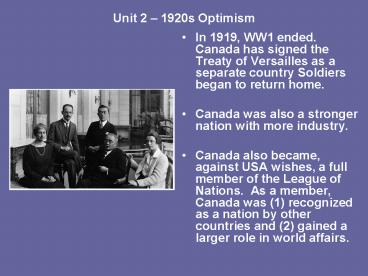Unit 2 - PowerPoint PPT Presentation
1 / 9
Title:
Unit 2
Description:
Canada has signed the Treaty of Versailles as a separate ... In 1929, the first quick-frozen fish fillets was introduced by Nova Scotian Archie Huntsman. ... – PowerPoint PPT presentation
Number of Views:51
Avg rating:3.0/5.0
Title: Unit 2
1
Unit 2 1920s Optimism
- In 1919, WW1 ended. Canada has signed the Treaty
of Versailles as a separate country Soldiers
began to return home. - Canada was also a stronger nation with more
industry. - Canada also became, against USA wishes, a full
member of the League of Nations. As a member,
Canada was (1) recognized as a nation by other
countries and (2) gained a larger role in world
affairs.
2
Unit 2 1920s Optimism
- The League of Nations
- The League of Nations was formed at the end of
WW1. Its role was to prevent war. It would do
so by a process of collective security. - Collective security means all nations defend each
other. If one country attacks a second country,
all the other countries will defend the second
country. The power of many would deter war.
3
Unit 2 1920s Optimism
- Canada was full of optimism.
- Canada was also moving away from
- British rule.
- In 1922, Canada does not support Great Britain in
a conflict with Turkey. Canada controls is own
foreign policy - In 1923, Canada and USA negotiate to a new
coastal fishing treaty. It is called the
Halibut Treaty. Great Britain does not represent
Canada. - In 1924, the Red Ensign replaces the British
Union Jack as Canadas flag.
4
Unit 2 1920s Optimism
- Canadians invented or discovered many things.
- In 1921, Frederick Banting and Charles Best
discovered insulin. It was used to treat
diabetes. They were awarded a Nobel Prize for
the achievement. - The Sir Adam Beck No. 1 Generating Stationat the
time the world's largest was opened in 1921 at
Niagara Falls to provide electricity. - In 1922, Mechanic Joseph-Armand Bombardier built
the first snowmobile - In 1925, Arthur Sicard invented the first
snow-blower. - In 1929, the first quick-frozen fish fillets was
introduced by Nova Scotian Archie Huntsman.
5
Unit 2 1920s Optimism
- The role of women in Canada was also changing.
- In 1920, Esther Marjorie Hill graduated from the
University of Toronto to become Canadas first
woman architect. - In 1921, Agnes Campbell Macphail became the first
woman elected as a Member of Parliament (MP) to
Canadas House of Commons. Macphail campaigned
for peace, civil liberties, social reform and the
cooperative movement. - In the 1928 Persons Case, the Supreme Court of
Canada unanimously decided women were not
"persons" who could hold public office as
Canadian Senators. In 1929 the British Privy
Council reversed the decision, ruled women were
legally "persons" and could become Senators.
6
Unit 2 1920s Optimism
- Canada was alive
- Jobs in factories (for men) were plentiful.
- Cities were growing in size.
- Entertainment included sports such as hockey and
football. - Many people owned cars and many other consumer
items such as radios, natural gas stoves, vaccum
cleaners and washing machines. - Women were socially freer. Pop culture was
flapper. The dance was the Charleston, and the
music was Big Band Jazz
7
Unit 2 1920s Optimism
- Could Canada keep growing?
- Trade with the USA
- Canadas biggest trading partner became the USA.
It was close, and many Americans wanted to buy
Canadian products. - Americans could build many things cheaper than
Canada. To protect Canadian companies, Canada
introduced TARIFFS. For example, a 35 tariff on
a American-built car would mean Canadians paid an
additional 35. in tax for 100. spent on the
American-built car. Canadians were forced to
buy Canadian products - Americans started to invest their money in
Canadian companies OR build branch plants in
Canada to avoid tariffs.
8
Unit 2 1920s Optimism
- Could Canada keep growing?
- As noted, people owned many big things such as
cars. Most of these things were bought ON
CREDIT. - The STOCK MARKET was booming, and everyone wanted
to invest and buy shares in companies to make
easy money. Many small investors bought stocks
ON MARGIN. This means buying stocks with
borrowed money. When the stock rises in value,
you pay back the loan and still make a profit. - Most of Canadas industrial growth was in HIGH
RISK AND HIGH COST NATURAL RESOURCE DEVELOPMENT
(e.g., pulp and paper, mining). - As noted, TARIFFS reduced Canadas international
trade while artificially supporting small
Canadian companies. - By 1928, 60 of Canadas trade was with the USA.
In other words, Canada was VERY DEPENDENT on the
USA. - Canadas economy was booming, and we were
PRODUCING MORE PRODUCTS THAN WE CONSUMED.
9
Unit 2 1920s Optimism
- THE GREAT CRASH
- On 29 December 1929, the stock market crashed.
This day is called BLACK TUESDAY. - Stock prices began to falland falland fall.
Between October 29 and November 13 (when stock
prices hit their lowest point), over 5 billion
had disappeared from Canadas economy. About 30
billion was lost in the USA in the same period. - By 1935, stocks had lost over 50 of their 1929
value. - Businesses closed, and Canadas unemployment
reached almost 27 (higher in some provinces). - Many families lost all their life savings.

